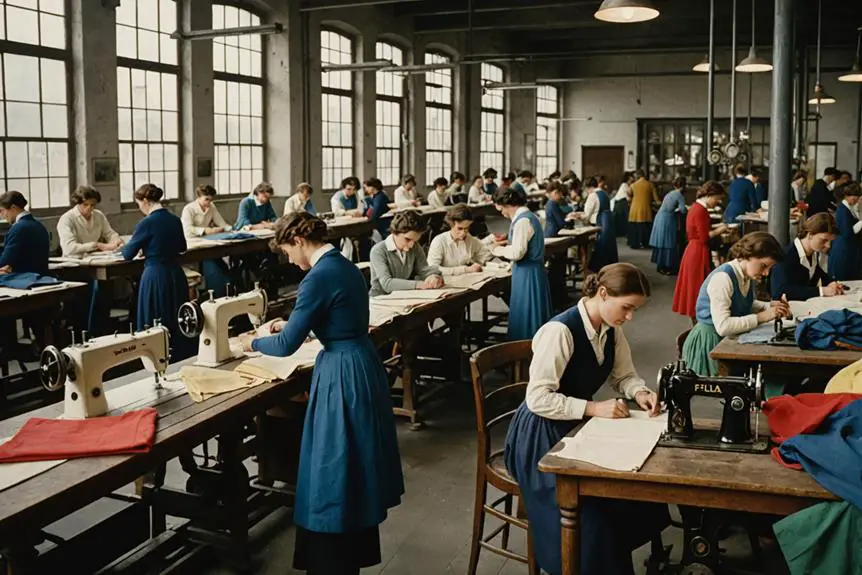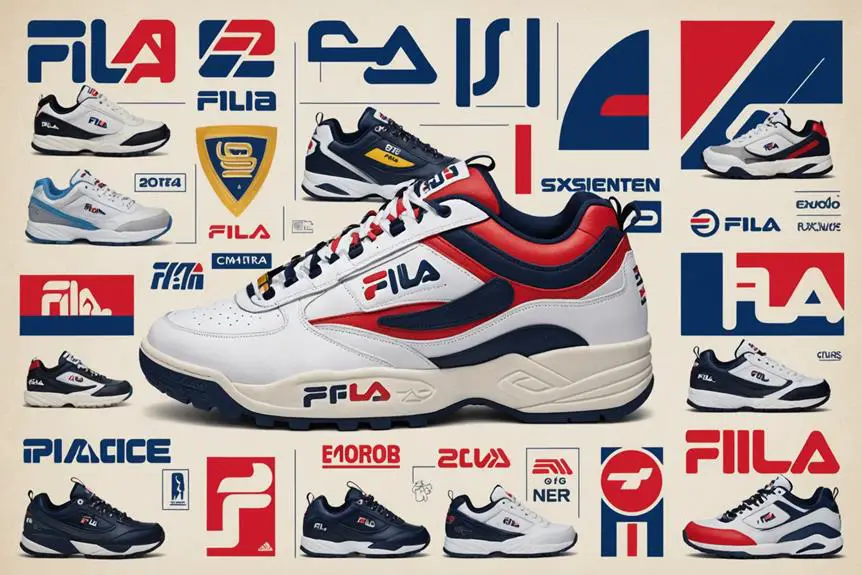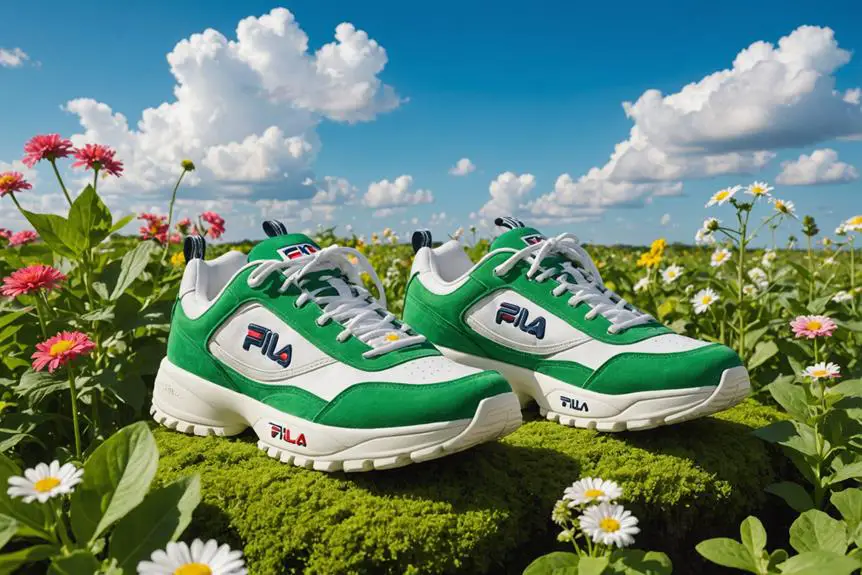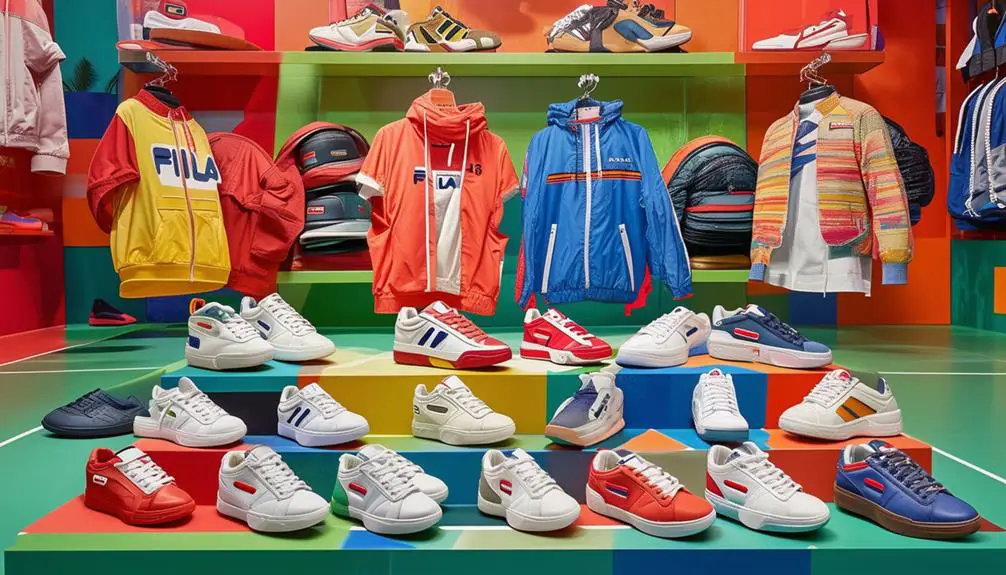Fila began its journey in 1911 as a textile company in Biella, Italy, initially concentrating on high-quality underwear. By the 1970s, the brand transitioned to sportswear, gaining significant recognition through endorsements, particularly from tennis legend Björn Borg. Fila flourished in the 1980s and 1990s, becoming a cultural icon within hip-hop and streetwear fashion. Following its acquisition by Fila Korea in 2007, the brand expanded its global reach. Today, Fila places a strong emphasis on sustainability and innovation while honoring its rich heritage. Each strategic shift reflects broader market trends and evolving consumer preferences, offering intriguing insights into Fila's storied history and future ambitions in the fashion industry.
Origins of Fila

Fila's journey began in 1911 when Ettore and Giansevero Fila established the company in Biella, Italy, primarily focusing on the production of quality textile goods, particularly underwear. It wasn't until 1923 that the company officially adopted the name F.I.L.A, expanding its production to include knitwear. This initial focus on textiles laid a solid foundation for future developments.
In the 1970s, Fila made a significant pivot into the sportswear market, a strategic move that would redefine its identity. The brand gained substantial recognition through endorsements from renowned tennis player Björn Borg, who became synonymous with Fila's innovative designs. In 1973, Fila launched its first tennis clothing line, particularly breaking the conventional all-white attire norm of the sport. This bold choice not only showcased Fila's commitment to style but also positioned it as a forward-thinking brand in the athletic apparel industry.
The shift from a local textile manufacturer to a prominent global sportswear brand marked an essential period in the History of Fila, characterized by innovative designs and effective marketing strategies that set the stage for its later success in the 1980s and 1990s.
Growth and Popularity
During the 1980s and 1990s, the evolution of Fila into a cultural phenomenon was driven by its strategic positioning within streetwear and sports. The brand's growth surged as it became synonymous with vibrant designs and bold logos, appealing to a diverse audience. Key endorsements from prominent figures, including tennis players like Björn Borg and basketball star Grant Hill, greatly enhanced Fila's visibility in the sportswear market.
| Year | Key Event | Impact |
|---|---|---|
| 1980s | Fila's rise in streetwear | Established cultural relevance |
| 1990s | Grant Hill endorsement | Boosted brand recognition |
| 1996 | 3rd largest athletic shoe maker | Solidified market position |
The re-release of classic models, such as the Fila Disruptor 2, demonstrates how nostalgia can fuel modern relevance. Collaborations with high-profile designers and celebrities further expanded Fila's appeal, ensuring it resonates with new generations while honoring its heritage. This blend of sports culture and street fashion solidified Fila's status and continued its growth trajectory in an increasingly competitive market.
Key Acquisitions and Changes

The evolution of Fila into a global sportswear powerhouse was not solely driven by its cultural impact but also by strategic acquisitions and management decisions. Fila Korea Ltd played a pivotal role in reshaping the Fila brand through key acquisitions that greatly expanded its reach and influence. Here are three vital steps in this transformation:
- In 2007, Fila Korea acquired the global business of Fila, marking a notable shift in brand management and direction.
- The company went public with an IPO on the Korea Exchange in 2010, which boosted its market presence and financial standing.
- In 2016, Fila Korea acquired Acushnet Holdings Corporation, adding renowned golf brands like Titleist and FootJoy to its portfolio.
These acquisitions not only enhanced Fila Holdings' market influence but also allowed the company to evolve from a European clothing focus to a robust global sportswear entity. The strategic management decisions behind these key acquisitions have been essential in solidifying Fila's position within the competitive sports and leisure market, ensuring its ongoing relevance and success.
Cultural Impact and Influence
Throughout the 1980s and 1990s, Fila emerged as a significant cultural force, particularly within hip-hop and R&B communities. Its tracksuits became staple casual wear, often showcased in music videos. Celebrities like Tupac Shakur and LL Cool J wore Fila products, enhancing the brand's visibility and establishing it as a cultural icon.
The strategic partnership with basketball star Grant Hill in the mid-1990s further solidified Fila's influence in the basketball apparel market. His signature sneakers gained traction among sneaker enthusiasts, showcasing Fila's ability to blend sports performance with streetwear style. The brand's bold logo and vibrant designs became synonymous with urban fashion trends, reflecting a shift from sportswear to lifestyle fashion that resonated with the youth market.
| Influential Figures | Cultural Impact | Key Products |
|---|---|---|
| Tupac Shakur | Elevated brand visibility | Tracksuits |
| LL Cool J | Established cultural relevance | Sneakers |
| Grant Hill | Dominated basketball apparel | Signature sneakers |
Through these efforts, Fila not only catered to athletes but also became a defining element of hip-hop culture and streetwear fashion.
Commitment to Sustainability

Fila's commitment to sustainability marks a significant shift in its approach to both production and consumer engagement. The brand has taken tangible steps toward ethical sourcing and eco-friendly materials, aiming to resonate with environmentally conscious consumers. This commitment reflects in several key initiatives:
- Fila has introduced vegan sneakers, showcasing its dedication to ethical sourcing and environmental responsibility.
- The brand emphasizes repurposing classic designs, minimizing waste and promoting sustainable fashion choices.
- Despite these efforts, Fila faces criticism regarding its sourcing of cotton from Xinjiang, where forced labor allegations raise questions about its ethical sourcing practices.
Future Aspirations and Goals
As Fila continues to strengthen its commitment to sustainability, it also sets its sights on ambitious future aspirations and goals that reflect both market demands and consumer expectations. The brand recognizes the importance of enhancing corporate governance practices to guarantee transparency and accountability within its operations. By focusing on these aspects, Fila aims to build trust and foster stronger relationships with its consumers.
In the pursuit of growth, Fila plans to leverage its established brand loyalty, driving continued expansion in global markets. This growth strategy will be supported by a commitment to innovation and brand development, enabling Fila to adapt to evolving consumer preferences and market trends effectively.
Sustainable growth strategies are at the forefront of Fila's future goals. The brand emphasizes aligning its operations with consumer appreciation and environmental considerations, guaranteeing that sustainability is woven into the fabric of its identity. Ultimately, Fila seeks to maximize long-term value for the group while preserving its heritage and relevance in the competitive sportswear industry. By staying true to these aspirations, Fila aims to solidify its position as a leader in both innovation and sustainability.
Frequently Asked Questions
What Is the Origin of Fila?
Fila originated in 1911, founded by Ettore and Giansevero Fila in Biella, Italy. They initially focused on high-quality textiles, later shifting to sportswear in the 1970s, greatly impacting both tennis and basketball culture.
What Was the Downfall of Fila?
Fila's downfall stemmed from its inability to adapt to market changes, losing consumer interest amid fierce competition. It struggled to maintain cultural relevance and failed to innovate, leading to financial instability and diminished brand appeal.
Who Currently Owns Fila?
You may find that Fila is currently owned by Fila Korea, which acquired the brand in 2007. Under this ownership, Fila has expanded its global operations and strengthened its market presence considerably.
Is Fila Italian or Korean?
Fila's identity blends Italian heritage with Korean ownership. While it was founded in Italy, it's currently operated by Fila Korea, which reflects a fusion of cultural influences in its branding and corporate strategy.





My family members all the time say that I am killing my time
here at web, except I know I am getting familiarity every
day by reading such good posts.
Can you be more specific about the content of your article? After reading it, I still have some doubts. Hope you can help me. https://accounts.binance.com/ar/register?ref=P9L9FQKY
https://jekyll.s3.us-east-005.backblazeb2.com/20250102-15/research/je-tall-sf-marketing-(219).html
There normally aren’t any set rules when it comes to MOB outfits for the wedding.
https://digi47sa.nyc3.digitaloceanspaces.com/research/digi47sa-(478).html
There usually aren’t any set rules when it comes to MOB outfits for
the wedding.
https://je-tall-marketing-775.tor1.digitaloceanspaces.com/research/je-marketing-(217).html
From neutral off-white numbers to daring, punchy, and fashion-forward designs, there’s one thing here that
will swimsuit her fancy.
Currently it looks like Expression Engine is the preferred blogging platform out there right now.
(from what I’ve read) Is that what you’re using on your blog?
Your article helped me a lot, is there any more related content? Thanks! https://www.binance.info/register?ref=P9L9FQKY